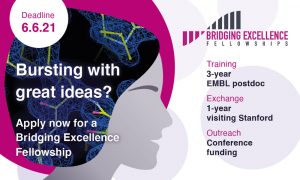
New therapies to improve cardiovascular health
Science & Technology EMBL researchers have made new strides into understanding and reversing genetic defects that underlie familial heart disease.
2023
sciencescience-technology

Science & Technology EMBL researchers have made new strides into understanding and reversing genetic defects that underlie familial heart disease.
2023
sciencescience-technology

Science & Technology EMBL researchers use a new cell sorting technology to gain new insights into cellular function in health and disease, as well as for other innovative applications.
2023
sciencescience-technology

Science & Technology Genomes are made up of thousands of individual pieces – genes – which are expressed at different levels. Researchers at EMBL have shed light on how the placement of a gene affects its expression, as well as that of its neighbours.
2022
sciencescience-technology

Science & Technology EMBL researchers, in collaboration with BD Biosciences, have demonstrated a new technology that allows rapid image-based sorting of cells. The new technology represents a major upgrade to flow cytometry and has applications in diverse life science fields.
2022
sciencescience-technology

Science & Technology EMBL scientists, together with collaborators from Heidelberg University, have provided further evidence of the gut’s role in COVID-19.
2021
sciencescience-technology

Science & Technology A new method has the potential to boost international research efforts to find drugs that eradicate cancer at its source.
2021
sciencescience-technology

EMBL AnnouncementsLab Matters Applications are now open for the Life Science Alliance’s Bridging Excellence Fellowships, enabling postdocs to carry out collaborative projects at EMBL and Stanford University.
2021
embl-announcementslab-matters

Science & Technology Researchers have found the cause of dilated cardiomyopathy – a leading cause of heart failure – and identified a potential treatment for it: a drug already used to treat acne.
2020
sciencescience-technology

Science & Technology Scientists at EMBL and Heidelberg University Hospital are studying how the novel coronavirus behaves in the gut to try to better understand its epidemiology and prevent its spread. To do this, they are combining advanced imaging and sequencing technologies to study coronavirus in human intestinal…
2020
sciencescience-technology

Science & Technology In a nutshell: Looping and unlooping DNA adjusts readout from gene and spread of regulation throughout the genome When a gene forms a loop, its output increases, as the transcription machinery that reads it is trapped into moving only along that gene When the gene loop is undone, transcription…
2012
sciencescience-technology

Science & Technology For many years, the mosquitoes that transmit malaria to humans were seen as public enemies, and campaigns to eradicate the disease focused on eliminating the mosquitoes. But, as a study published today in Science shows, the mosquitoes can also be our allies in the fight against this common foe,…
2009
sciencescience-technology
Science & Technology Genes that contain instructions for making proteins make up less than 2% of the human genome. Yet, for unknown reasons, most of our genome is transcribed into RNA. The same is true for many other organisms that are easier to study than humans. Researchers in the groups of Lars Steinmetz at the…
2009
sciencescience-technology
Looking for past print editions of EMBLetc.? Browse our archive, going back 20 years.
EMBLetc. archive